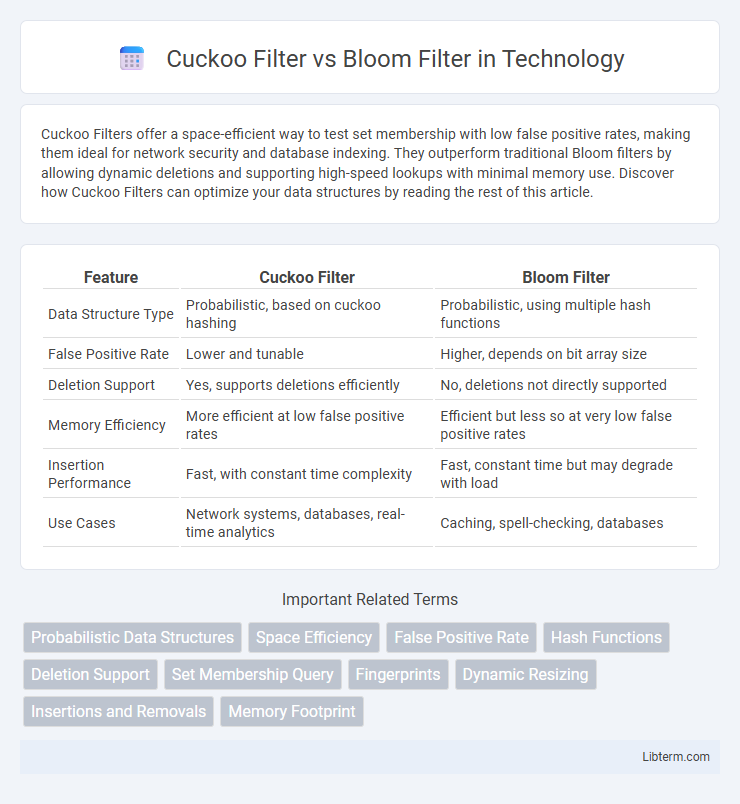Cuckoo Filters offer a space-efficient way to test set membership with low false positive rates, making them ideal for network security and database indexing. They outperform traditional Bloom filters by allowing dynamic deletions and supporting high-speed lookups with minimal memory use. Discover how Cuckoo Filters can optimize your data structures by reading the rest of this article.
Table of Comparison
| Feature | Cuckoo Filter | Bloom Filter |
|---|---|---|
| Data Structure Type | Probabilistic, based on cuckoo hashing | Probabilistic, using multiple hash functions |
| False Positive Rate | Lower and tunable | Higher, depends on bit array size |
| Deletion Support | Yes, supports deletions efficiently | No, deletions not directly supported |
| Memory Efficiency | More efficient at low false positive rates | Efficient but less so at very low false positive rates |
| Insertion Performance | Fast, with constant time complexity | Fast, constant time but may degrade with load |
| Use Cases | Network systems, databases, real-time analytics | Caching, spell-checking, databases |
Introduction to Probabilistic Data Structures
Probabilistic data structures like Cuckoo filters and Bloom filters efficiently test set membership with controlled false positive rates. Cuckoo filters improve upon Bloom filters by supporting item deletions and typically offering lower false positive rates at similar space costs. These structures balance memory usage and query speed, making them ideal for applications requiring fast, approximate set membership tests.
What is a Bloom Filter?
A Bloom Filter is a space-efficient probabilistic data structure used to test whether an element is a member of a set, allowing for false positives but no false negatives. It employs multiple hash functions to map elements to a bit array, setting bits corresponding to each hash index. Widely utilized in databases, networks, and caching systems, Bloom Filters optimize membership queries while minimizing memory usage.
How Does a Cuckoo Filter Work?
A Cuckoo Filter uses hashing to store and check membership by inserting fingerprints of items into multiple possible buckets, allowing efficient lookups and deletions. It leverages cuckoo hashing to relocate existing fingerprints if a collision occurs, ensuring high space efficiency and low false positive rates. Unlike Bloom Filters, Cuckoo Filters support dynamic operations and provide faster query times with better accuracy in many practical use cases.
Memory Efficiency Comparison
Cuckoo filters offer superior memory efficiency compared to Bloom filters by enabling dynamic deletion and lower false positive rates with fewer bits per element, typically requiring around 1.2 to 1.5 bits per item versus Bloom filters' 9.6 bits for a 1% false positive rate. Their use of fingerprint hashing and cuckoo hashing reduces storage overhead, allowing more compact representations in memory. This efficiency makes cuckoo filters preferable in applications with frequent updates and constrained memory environments.
Query Performance: Speed and Accuracy
Cuckoo Filters offer faster query performance than Bloom Filters due to their ability to confirm absence and presence with fewer memory accesses and lower false positive rates. Bloom Filters rely on multiple hash functions, making queries slower and more prone to false positives, especially with large datasets. The adaptability of Cuckoo Filters in handling dynamic sets enhances accuracy and speed in membership tests compared to static Bloom Filters.
False Positive Rates: Cuckoo vs Bloom
Cuckoo Filters typically exhibit lower false positive rates than Bloom Filters for the same memory footprint due to their ability to store fingerprints directly rather than hash bits. Bloom Filters tend to have higher false positive probabilities as their false positive rate approximates (1 - e^(-kn/m))^k, where k is the number of hash functions, n the number of inserted elements, and m the filter size. Cuckoo Filters maintain better performance and accuracy in dynamic datasets because they support deletions and replacements, reducing false positives over time compared to static Bloom Filters.
Support for Deletions
Cuckoo Filters support deletions efficiently by using a cuckoo hashing scheme that allows entries to be uniquely identified and removed without false negatives. Bloom Filters, in their standard form, do not support deletions because clearing bits can cause false negatives, although Counting Bloom Filters are an extension that enables deletions by maintaining counters for each bit. The deletion capability of Cuckoo Filters makes them more suitable for dynamic datasets where elements need to be frequently inserted and removed.
Practical Use Cases and Application Scenarios
Cuckoo filters excel in network security applications by efficiently supporting dynamic set membership with deletions, making them ideal for intrusion detection systems and database query optimization. Bloom filters are widely used in distributed systems and caching, such as web browsers and blockchain, where space efficiency and fast membership queries are crucial but deletions are rare. In real-time analytics and large-scale data processing, Cuckoo filters provide lower false positive rates at comparable memory footprints, enhancing accuracy over traditional Bloom filters.
Implementation Complexity and Overhead
Cuckoo filters boast simpler implementation and lower overhead compared to Bloom filters due to their use of Cuckoo hashing and fingerprinting, enabling efficient insertion, deletion, and membership queries. Bloom filters involve multiple hash functions and bit arrays, which increase complexity and make deletion operations costly or approximate. The compactness of Cuckoo filters and their support for dynamic updates reduce memory overhead and maintain high lookup performance, making them preferable in scenarios requiring flexible data management.
Choosing the Right Filter: Key Takeaways
Choosing the right filter depends on the specific requirements of your application, such as memory efficiency and false positive rates. Cuckoo Filters offer better support for deletions and lower false positive probabilities compared to Bloom Filters, making them suitable for dynamic datasets. Bloom Filters, however, provide simpler implementation and efficient querying for static or append-only data with predictable size.
Cuckoo Filter Infographic

 libterm.com
libterm.com